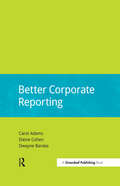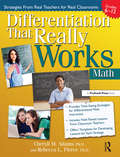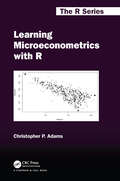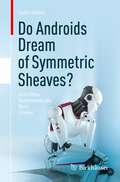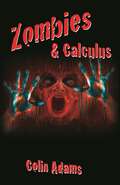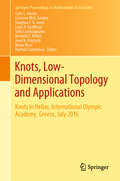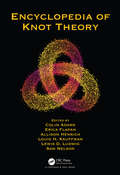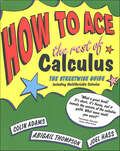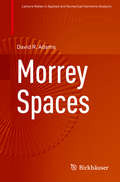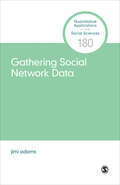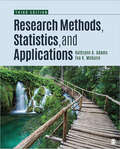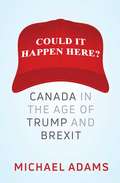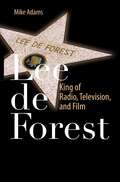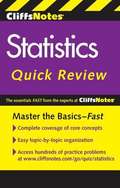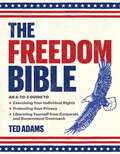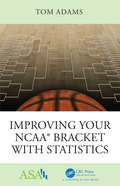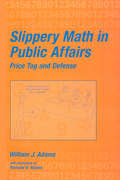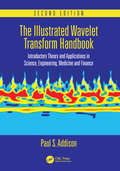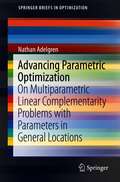- Table View
- List View
Better Corporate Reporting (Doshorts Ser.)
by Carol Adams Elaine Cohen Dwayne BarakaBetter Corporate Reporting outlines the latest frameworks for enhancing non-financial and sustainability reporting. It shows you how to integrate non-financial data into your reporting and overall strategy, creating long-term value, trust and transparency. It includes guides to: the International Integrated Reporting Council's new framework; the Global Reporting Initiative's G4 framework; and a detailed look at the concept at the heart of both of these new frameworks, materiality. It is the compilation of 3 bestselling sustainability guides on sustainability reporting.Understanding Integrated Reporting provides a practical and expert distillation of the new IR framework released by the International Integrated Reporting Council in December 2013. It explains what IR is and how to do it; how it links with other reporting frameworks and what it means in terms of thinking and processes. You'll also get a clear business case for IR and insights and best practice examples from leading integrated reporters. The Global Reporting Initiative (GRI) G4 Sustainability Reporting Framework was launched in May 2013. In Understanding G4, corporate reporting veteran Elaine Cohen presents an easy-to-follow review of everything any organization needs to know to decide whether to use the G4 Framework and if so, how. Materiality is the lynch-pin that can align your sustainability initiatives with your overall strategy. Making Sustainability Matter shows you how to identify your organization's most material sustainability issues, allocate resources to sustainability initiatives for optimal returns; connect your communications and reporting to materiality, and; clarify which issues are important to your stakeholders. Materiality is a core concept in both the GRI's new G4 framework the IIRC's new Integrated Reporting framework.
Differentiation That Really Works: Math (Grades 6-12)
by Cheryll M. Adams Rebecca L. PierceDifferentiation That Really Works: Math (6-12) provides time-saving tips and strategies from real teachers who teach math in grades 6-12. These teachers not only developed the materials and used them in their own classes, but they also provided useful feedback and comments about the activities. The strategies included in the book are tiered lessons, cubing, graphic organizers, exit cards, learning contracts, and choice boards. Every strategy includes directions and offers opportunities for differentiation.Grades 6-12
Learning Microeconometrics with R (Chapman & Hall/CRC The R Series)
by Christopher P. AdamsThis book provides an introduction to the field of microeconometrics through the use of R. The focus is on applying current learning from the field to real world problems. It uses R to both teach the concepts of the field and show the reader how the techniques can be used. It is aimed at the general reader with the equivalent of a bachelor’s degree in economics, statistics or some more technical field. It covers the standard tools of microeconometrics, OLS, instrumental variables, Heckman selection and difference in difference. In addition, it introduces bounds, factor models, mixture models and empirical Bayesian analysis. Key Features: Focuses on the assumptions underlying the algorithms rather than their statistical properties. Presents cutting-edge analysis of factor models and finite mixture models. Uses a hands-on approach to examine the assumptions made by the models and when the models fail to estimate accurately. Utilizes interesting real-world data sets that can be used to analyze important microeconomic problems. Introduces R programming concepts throughout the book. Includes appendices that discuss some of the standard statistical concepts and R programming used in the book.
Do Androids Dream of Symmetric Sheaves?: And Other Mathematically Bent Stories
by Colin AdamsWhy is the Devil thrilled when Hell gets its first mathematician? How do 6 and 27 solve the diabolical murder of 9? What are the advantages a vampire has in the math world? What happens when we run out of new math to discover? How does Dr. Frankenstein create the ideal mathematical creature? What transpires when a grad student digging for theorems strikes a rich vein on the ridge overlooking Deadwood? What happens when math students band together to foment rebellion? What will a mathematician do beyond the grave to finish that elusive proof?This is just a small subset of the questions plumbed in this collection of 45 mathematically bent stories from the fertile imagination of Colin Adams. Originally appearing in The Mathematical Intelligencer, an expository mathematics magazine, these tales give a decidedly unconventional look at the world of mathematics and mathematicians. A section of notes is provided at the end of the book that explain references that may not be familiar to all and that include additional commentary by the author.
Zombies and Calculus
by Colin AdamsA novel that uses calculus to help you survive a zombie apocalypseHow can calculus help you survive the zombie apocalypse? Colin Adams, humor columnist for the Mathematical Intelligencer and one of today's most outlandish and entertaining popular math writers, demonstrates how in this zombie adventure novel.Zombies and Calculus is the account of Craig Williams, a math professor at a small liberal arts college in New England, who, in the middle of a calculus class, finds himself suddenly confronted by a late-arriving student whose hunger is not for knowledge. As the zombie virus spreads and civilization crumbles, Williams uses calculus to help his small band of survivors defeat the hordes of the undead. Along the way, readers learn how to avoid being eaten by taking advantage of the fact that zombies always point their tangent vector toward their target, and how to use exponential growth to determine the rate at which the virus is spreading. Williams also covers topics such as logistic growth, gravitational acceleration, predator-prey models, pursuit problems, the physics of combat, and more. With the aid of his story, you too can survive the zombie onslaught.Featuring easy-to-use appendixes that explain the book's mathematics in greater detail, Zombies and Calculus is suitable both for those who have only recently gotten the calculus bug, as well as for those whose disease has advanced to the multivariable stage.
Knots, Low-Dimensional Topology and Applications: Knots in Hellas, International Olympic Academy, Greece, July 2016 (Springer Proceedings in Mathematics & Statistics #284)
by Colin C. Adams Cameron McA. Gordon Vaughan F. R. Jones Louis H. Kauffman Sofia Lambropoulou Kenneth C. Millett Jozef H. Przytycki Renzo Ricca Radmila SazdanovicThis proceedings volume presents a diverse collection of high-quality, state-of-the-art research and survey articles written by top experts in low-dimensional topology and its applications. The focal topics include the wide range of historical and contemporary invariants of knots and links and related topics such as three- and four-dimensional manifolds, braids, virtual knot theory, quantum invariants, braids, skein modules and knot algebras, link homology, quandles and their homology; hyperbolic knots and geometric structures of three-dimensional manifolds; the mechanism of topological surgery in physical processes, knots in Nature in the sense of physical knots with applications to polymers, DNA enzyme mechanisms, and protein structure and function. The contents is based on contributions presented at the International Conference on Knots, Low-Dimensional Topology and Applications – Knots in Hellas 2016, which was held at the International Olympic Academy in Greece in July 2016. The goal of the international conference was to promote the exchange of methods and ideas across disciplines and generations, from graduate students to senior researchers, and to explore fundamental research problems in the broad fields of knot theory and low-dimensional topology. This book will benefit all researchers who wish to take their research in new directions, to learn about new tools and methods, and to discover relevant and recent literature for future study.
Encyclopedia of Knot Theory
by Colin Adams Erica Flapan Allison Henrich Louis H. Kauffman Lewis D. Ludwig Sam Nelson"Knot theory is a fascinating mathematical subject, with multiple links to theoretical physics. This enyclopedia is filled with valuable information on a rich and fascinating subject." – Ed Witten, Recipient of the Fields Medal "I spent a pleasant afternoon perusing the Encyclopedia of Knot Theory. It’s a comprehensive compilation of clear introductions to both classical and very modern developments in the field. It will be a terrific resource for the accomplished researcher, and will also be an excellent way to lure students, both graduate and undergraduate, into the field." – Abigail Thompson, Distinguished Professor of Mathematics at University of California, Davis Knot theory has proven to be a fascinating area of mathematical research, dating back about 150 years. Encyclopedia of Knot Theory provides short, interconnected articles on a variety of active areas in knot theory, and includes beautiful pictures, deep mathematical connections, and critical applications. Many of the articles in this book are accessible to undergraduates who are working on research or taking an advanced undergraduate course in knot theory. More advanced articles will be useful to graduate students working on a related thesis topic, to researchers in another area of topology who are interested in current results in knot theory, and to scientists who study the topology and geometry of biopolymers. Features Provides material that is useful and accessible to undergraduates, postgraduates, and full-time researchers Topics discussed provide an excellent catalyst for students to explore meaningful research and gain confidence and commitment to pursuing advanced degrees Edited and contributed by top researchers in the field of knot theory
How to Ace the Rest of Calculus: The Streetwise Guide (How to Ace)
by Colin Adams Abigail Thompson Joel HassThe sequel to How to Ace Calculus, How to Ace the Rest of Calculus provides humorous and highly readable explanations of the key topics of second and third semester calculus-such as sequences and series, polor coordinates, and multivariable calculus-without the technical details and fine print that would be found in a formal text.
Morrey Spaces
by David R. AdamsIn this set of lecture notes, the author includes some of the latest research on the theory of Morrey Spaces associated with Harmonic Analysis. There are three main claims concerning these spaces that are covered: determining the integrability classes of the trace of Riesz potentials of an arbitrary Morrey function; determining the dimensions of singular sets of weak solutions of PDE (e. g. The Meyers-Elcart System); and determining whether there are any "full" interpolation results for linear operators between Morrey spaces. This book will serve as a useful reference to graduate students and researchers interested in Potential Theory, Harmonic Analysis, PDE, and/or Morrey Space Theory.
Gathering Social Network Data (Quantitative Applications in the Social Sciences #180)
by jimi adamsGathering Social Network Data fills an important gap in the literature by focusing on methods for designing, collecting, and evaluating the data that are the subject of these analytic techniques. Author jimi adams draws on his extensive teaching experience to provide a guide that can be used by both novice and more experienced researchers alike. The volume focuses on principles, with the goal of providing readers the tools needed to develop their own approach to gathering social network data.
Gathering Social Network Data (Quantitative Applications in the Social Sciences #180)
by jimi adamsGathering Social Network Data fills an important gap in the literature by focusing on methods for designing, collecting, and evaluating the data that are the subject of these analytic techniques. Author jimi adams draws on his extensive teaching experience to provide a guide that can be used by both novice and more experienced researchers alike. The volume focuses on principles, with the goal of providing readers the tools needed to develop their own approach to gathering social network data.
Research Methods, Statistics, and Applications
by Kathrynn A. Adams Eva Kung McGuire (aka: Lawrence)Research Methods, Statistics, and Applications by Kathrynn A. Adams and Eva K. McGuire is designed to give students the experience of being a researcher by combining the interrelated concepts of research methods and statistics to better explain how the research process incorporates both elements. Employing a conversational tone throughout, coupled with an emphasis on decision-making, this best-selling text will spark students’ interest in conducting research and improve their ability to critically analyze research in their daily lives. The Third Edition includes a new chapter on measurement to better highlight its critical importance, updates for the 7th edition of the Publication Manual of the American Psychological Association, new examples related to social justice, additional sections on qualitative research methods, and more thorough integration of research ethics information and tips throughout each chapter.
Research Methods, Statistics, and Applications
by Kathrynn A. Adams Eva Kung McGuire (aka: Lawrence)Research Methods, Statistics, and Applications by Kathrynn A. Adams and Eva K. McGuire is designed to give students the experience of being a researcher by combining the interrelated concepts of research methods and statistics to better explain how the research process incorporates both elements. Employing a conversational tone throughout, coupled with an emphasis on decision-making, this best-selling text will spark students’ interest in conducting research and improve their ability to critically analyze research in their daily lives. The Third Edition includes a new chapter on measurement to better highlight its critical importance, updates for the 7th edition of the Publication Manual of the American Psychological Association, new examples related to social justice, additional sections on qualitative research methods, and more thorough integration of research ethics information and tips throughout each chapter.
Student Study Guide With IBM® SPSS® Workbook for Research Methods, Statistics, and Applications
by Kathrynn A. Adams Eva Kung McGuire (aka: Lawrence)The third edition of the Student Study Guide With IBM® SPSS® Workbook for Research Methods, Statistics, and Applications by Kathrynn A. Adams and Eva K. McGuire gives students even more opportunities to practice and apply their knowledge in statistics and research methods. Written by the authors of Research Methods, Statistics, and Applications, the third edition of the study guide follows the third edition of the textbook for straightforward assigning and practice. New features include practice quizzes to give students both recognition and recall activities for better retention. Learning objectives and brief chapter summaries from the main text remind students of what they′ve learned and orient students toward the exercises. In-depth exercises encourage students to build on their knowledge, requiring students to think critically and actively engage with the material. These exercises have been condensed and focus on moving students through the learning objectives at a quick pace. At the end of most chapters, "Your Research" sections encourage students to apply concepts to their own projects. Now placed at the end of book, the IBM® SPSS® workbook provides instructions for performing statistical calculations. Included in this workbook are additional exercises to practice data analysis and interpretation using the software. Answers to quizzes are listed immediately after each quiz in the book while answers to exercises are listed on the instructor resources website.
Student Study Guide With IBM® SPSS® Workbook for Research Methods, Statistics, and Applications
by Kathrynn A. Adams Eva Kung McGuire (aka: Lawrence)The third edition of the Student Study Guide With IBM® SPSS® Workbook for Research Methods, Statistics, and Applications by Kathrynn A. Adams and Eva K. McGuire gives students even more opportunities to practice and apply their knowledge in statistics and research methods. Written by the authors of Research Methods, Statistics, and Applications, the third edition of the study guide follows the third edition of the textbook for straightforward assigning and practice. New features include practice quizzes to give students both recognition and recall activities for better retention. Learning objectives and brief chapter summaries from the main text remind students of what they′ve learned and orient students toward the exercises. In-depth exercises encourage students to build on their knowledge, requiring students to think critically and actively engage with the material. These exercises have been condensed and focus on moving students through the learning objectives at a quick pace. At the end of most chapters, "Your Research" sections encourage students to apply concepts to their own projects. Now placed at the end of book, the IBM® SPSS® workbook provides instructions for performing statistical calculations. Included in this workbook are additional exercises to practice data analysis and interpretation using the software. Answers to quizzes are listed immediately after each quiz in the book while answers to exercises are listed on the instructor resources website.
Could It Happen Here?: Canada in the Age of Trump and Brexit
by Michael AdamsFrom award-winning author Michael Adams, Could It Happen Here? draws on groundbreaking new social research to show whether Canadian society is at risk of the populist forces afflicting other parts of the world.Americans elected Donald Trump. Britons opted to leave the European Union. Far-right, populist politicians channeling anger at out-of-touch “elites” are gaining ground across Europe. In vote after shocking vote, citizens of Western democracies have pushed their anger to the top of their governments’ political agendas. The votes have varied in their particulars, but their unifying feature has been rejection of moderation, incrementalism, and the status quo. Amid this roiling international scene, Canada appears placid, at least on the surface. As other societies retrench, the international media have taken notice of Canada’s welcome of Syrian refugees, its half-female federal cabinet, and its acceptance of climate science and mixed efforts to limit its emissions. After a year in power, the centrist federal government continues to enjoy majority approval, suggesting an electorate not as bitterly split as the ones to the south or in Europe. As sceptics point out, however, Brexit and a Trump presidency were unthinkable until they happened. Could it be that Canada is not immune to the same forces of populism, social fracture, and backlash that have afflicted other parts of the world? Our largest and most cosmopolitan city elected Rob Ford. Conservative Party leadership hopeful Kellie Leitch proposes a Canadian values test for immigrants and has called the Trump victory “exciting.” Anti-tax demonstrators in Alberta chanted “lock her up” in reference to Premier Rachel Notley, an elected leader accused of no wrongdoing, only policy positions the protesters disliked. Pollster and social values researcher Michael Adams takes Canadians into the examining room to see whether we are at risk of coming down with the malaise affecting other Western democracies. Drawing on major social values surveys of Canadians and Americans in 2016—as well as decades of tracking data in both countries—Adams examines our economy, institutions, and demographics to answer the question: could it happen here?
Lee de Forest
by Mike AdamsThe life-long inventor, Lee de Forest invented the three-element vacuum tube used between 1906 and 1916 as a detector, amplifier, and oscillator of radio waves. Beginning in 1918 he began to develop a light valve, a device for writing and reading sound using light patterns. While he received many patents for his process, he was initially ignored by the film industry. In order to promote and demonstrate his process he made several hundred sound short films, he rented space for their showing; he sold the tickets and did the publicity to gain audiences for his invention. Lee de Forest officially brought sound to film in 1919. Lee De Forest: King of Radio, Television, and Film is about both invention and early film making; de Forest as the scientist and producer, director, and writer of the content. This book tells the story of de Forest's contribution in changing the history of film through the incorporation of sound. The text includes primary source historical material, U.S. patents and richly-illustrated photos of Lee de Forest's experiments. Readers will greatly benefit from an understanding of the transition from silent to audio motion pictures, the impact this had on the scientific community and the popular culture, as well as the economics of the entertainment industry.
CliffsNotes Statistics Quick Review, 2nd Edition
by Scott Adams David H Voelker Peter Z OrtonInside the Book: Graphic displays Numerical measures Probability Sampling Principles of testing Univariate inferential tests Bivariate relationships Review questions Resource center Glossary Common mistakes Tables Why CliffsNotes? Go with the name you know and trust Get the information you need-fast! CliffsNotes Quick Review guides give you a clear, concise, easy-to-use review of the basics. Introducing each topic, defining key terms, and carefully walking you through sample problems, this guide helps you grasp and understand the important concepts needed to succeed. Access 500 additional practice questions at www.cliffsnotes.com/go/quiz/statistics Master the Basics-Fast Complete coverage of core concepts Easy topic-by-topic organization Access hundreds of practice problems at www.cliffsnotes.com/go/quiz/statistics
The Freedom Bible: An A-to-Z Guide to Exercising Your Individual Rights, Protecting Your Privacy, Liberating Yourself from Corporate and Government Overreach
by Ted AdamsLearn How to Protect Your Family&’s Freedom!Freedom is the foundation on which America was born and continues to thrive. If you believe in the strength of freedom as more than an ideal, you can find smart ways to exercise it in all parts of your life! The Freedom Bible is your A-to-Z guide to knowing your individual rights and seeking more control and freedom through the decisions you face every day.Own healthcare decisions for you and your familyMake choices that direct your dollars where you want—for example, made in America, not overseasKnow your options to challenge governing boards—from home ownership associations to school boardsReduce your reliance on &“the grid&”Escape the invasiveness of all kinds of technologyGuard your privacy and free speech on social mediaAnd much more!Get freedom from…· Big Government· Big Tech· Dependence on Overseas Goods· Employer &“Requirements&”· HOAs· Social media jail· Spam callers· Taxes· And More!
Go Math! Florida [Grade 1]
by Thomasenia Lott Adams Juli K. Dixon Matt LarsonNIMAC-sourced textbook
Go Math! Florida [Grade 2]
by Thomasenia Lott Adams Juli K. Dixon Matt LarsonNIMAC-sourced textbook
Improving Your NCAA® Bracket with Statistics (ASA-CRC Series on Statistical Reasoning in Science and Society)
by Tom AdamsTwenty-four million people wager nearly $3 billion on college basketball pools each year, but few are aware that winning strategies have been developed by researchers at Harvard, Yale, and other universities over the past two decades. Bad advice from media sources and even our own psychological inclinations are often a bigger obstacle to winning than our pool opponents. Profit opportunities are missed and most brackets submitted to pools don’t have a breakeven chance to win money before the tournament begins. Improving Your NCAA® Bracket with Statistics is both an easy-to-use tip sheet to improve your winning odds and an intellectual history of how statistical reasoning has been applied to the bracket pool using standard and innovative methods. It covers bracket improvement methods ranging from those that require only the information in the seeded bracket to sophisticated estimation techniques available via online simulations. Included are: Prominently displayed bracket improvement tips based on the published research A history of the origins of the bracket pool A history of bracket improvement methods and their results in play Historical sketches and background information on the mathematical and statistical methods that have been used in bracket analysis A source list of good bracket pool advice available each year that seeks to be comprehensive Warnings about common bad advice that will hurt your chances Tom Adams’ work presenting bracket improvement methods has been featured in the New York Times, Sports Illustrated, and SmartMoney magazine.
Slippery Math In Public Affairs: Price Tag And Defense
by William J. AdamsHighlighting how slippery numbers and questionable mathematical conclusions emerge and what can be done to safeguard against them, this book examines flawed usage of math in public affairs through actual cases of how mathematical data and conclusions can be distorted and misrepresented to influence public opinion. The author analyzes the cost of "s
The Illustrated Wavelet Transform Handbook: Introductory Theory and Applications in Science, Engineering, Medicine and Finance, Second Edition
by Paul S. AddisonThis second edition of The Illustrated Wavelet Transform Handbook: Introductory Theory and Applications in Science, Engineering, Medicine and Finance has been fully updated and revised to reflect recent developments in the theory and practical applications of wavelet transform methods. The book is designed specifically for the applied reader in science, engineering, medicine and finance. Newcomers to the subject will find an accessible and clear account of the theory of continuous and discrete wavelet transforms, while readers already acquainted with wavelets can use the book to broaden their perspective. One of the many strengths of the book is its use of several hundred illustrations, some in colour, to convey key concepts and their varied practical uses. Chapters exploring these practical applications highlight both the similarities and differences in wavelet transform methods across different disciplines and also provide a comprehensive list of over 1000 references that will serve as a valuable resource for further study. Paul Addison is a Technical Fellow with Medtronic, a global medical technology company. Previously, he was co-founder and CEO of start-up company, CardioDigital Ltd (and later co-founded its US subsidiary, CardioDigital Inc) - a company concerned with the development of novel wavelet-based methods for biosignal analysis. He has a master’s degree in engineering and a PhD in fluid mechanics, both from the University of Glasgow, Scotland (founded 1451). His former academic life as a tenured professor of fluids engineering included the output of a large number of technical papers, covering many aspects of engineering and bioengineering, and two textbooks: Fractals and Chaos: An Illustrated Course and the first edition of The Illustrated Wavelet Transform Handbook. At the time of publication, the author has over 100 issued US patents concerning a wide range of medical device technologies, many of these concerning the wavelet transform analysis of biosignals. He is both a Chartered Engineer and Chartered Physicist.
Advancing Parametric Optimization: On Multiparametric Linear Complementarity Problems with Parameters in General Locations (SpringerBriefs in Optimization)
by Nathan AdelgrenThe theory presented in this work merges many concepts from mathematical optimization and real algebraic geometry. When unknown or uncertain data in an optimization problem is replaced with parameters, one obtains a multi-parametric optimization problem whose optimal solution comes in the form of a function of the parameters.The theory and methodology presented in this work allows one to solve both Linear Programs and convex Quadratic Programs containing parameters in any location within the problem data as well as multi-objective optimization problems with any number of convex quadratic or linear objectives and linear constraints. Applications of these classes of problems are extremely widespread, ranging from business and economics to chemical and environmental engineering. Prior to this work, no solution procedure existed for these general classes of problems except for the recently proposed algorithms
